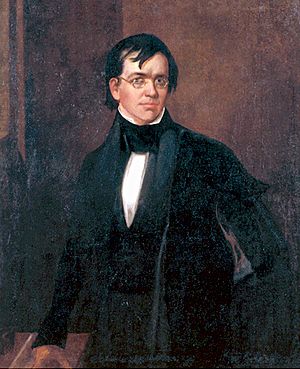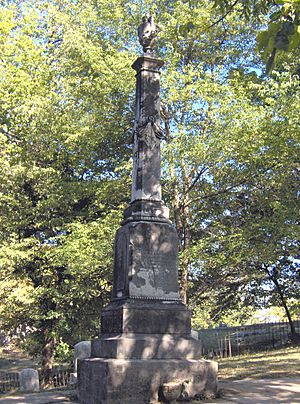James Turner Morehead (Kentucky politician) facts for kids
Quick facts for kids
James Turner Morehead
|
|
|---|---|
 |
|
| United States Senator from Kentucky |
|
| In office March 4, 1841 – March 3, 1847 |
|
| Preceded by | John J. Crittenden |
| Succeeded by | Joseph R. Underwood |
| 12th Governor of Kentucky | |
| In office February 21, 1834 – August 30, 1836 |
|
| Lieutenant | Vacant |
| Preceded by | John Breathitt |
| Succeeded by | James Clark |
| 10th Lieutenant Governor of Kentucky | |
| In office September 4, 1832 – February 21, 1834 |
|
| Governor | John Breathitt |
| Preceded by | John Breathitt |
| Succeeded by | Charles A. Wickliffe |
| Member of the Kentucky House of Representatives | |
| In office 1828–1831 |
|
| Personal details | |
| Born | May 24, 1797 Bullitt County, Kentucky |
| Died | December 28, 1854 (aged 57) Covington, Kentucky |
| Resting place | Frankfort Cemetery |
| Political party | National Republican, Whig |
| Spouse | Susan A. Roberts |
| Relations | Cousin of John Motley Morehead |
| Alma mater | Transylvania University |
| Profession | Lawyer |
James Turner Morehead (born May 24, 1797 – died December 28, 1854) was an important American politician. He served as a United States Senator and was the 12th Governor of Kentucky. He holds a special place in history as the first governor of Kentucky who was actually born in the state. Morehead was a member of the National Republican Party, led by Henry Clay. He joined politics when his party was just starting to challenge the powerful Democratic Party in Kentucky.
In 1831, Morehead was chosen to run for lieutenant governor. He won the election, even though the candidate for governor from his own party lost. He became governor in 1834 after Governor John Breathitt passed away. Because his time as governor was cut short, he focused on a safe and popular issue: improving Kentucky's roads, canals, and rivers. When his party changed its name to the Whig Party in 1834, Morehead hosted their very first meeting in Frankfort.
After being governor, Morehead continued to serve in the state legislature. He later became a U.S. Senator, where he worked closely with Henry Clay. He retired in 1847 and practiced law until his death in 1854. The city of Morehead, Kentucky is named in his honor.
Contents
Early Life and Becoming a Lawyer
James Turner Morehead was born on May 24, 1797, near Shepherdsville, Kentucky, in Bullitt County. His parents, Armistead and Lucy Morehead, moved to Russellville, Kentucky when he was very young. He went to public schools there. From 1813 to 1815, he studied at Transylvania University in Lexington, Kentucky.
After college, he went back to Russellville to study law. He learned from judge H. P. Broadnax and John J. Crittenden. In 1818, he passed his exams and became a lawyer, starting his practice in Bowling Green, Kentucky.
On May 1, 1823, Morehead married Susan A. Roberts. They had two children together. He was elected to the Kentucky House of Representatives for Warren County from 1828 to 1831. While there, he worked on a committee that focused on improving roads and waterways. He helped create a bill in 1831 to fund the construction of a major road between Maysville and Lexington.
Serving as Governor of Kentucky
In 1831, Morehead attended a big meeting in Baltimore, Maryland, where Henry Clay was nominated to run for president. At this meeting, Morehead himself was chosen to run for lieutenant governor. Even though his running mate for governor lost, Morehead won and became the ninth Lieutenant Governor of Kentucky.
Governor John Breathitt passed away on February 21, 1834. The very next day, Morehead became governor. This change from a Democratic governor to one from the rival National Republican party made some Democrats worried. However, Morehead kept Governor Breathitt's Secretary of State, Lewis Saunders, which helped calm their fears.
Later that year, the National Republican party started calling itself the Whig Party. This new name first appeared in a newspaper in April 1834. On July 4, 1834, Governor Morehead hosted the party's first official meeting in Frankfort. Many Kentuckians joined the "new" party. In the elections that August, the Whig Party won most of the seats in both parts of the state legislature. They used their new power to make changes, like sending John J. Crittenden to the United States Senate in 1835 instead of a Democrat.
In his first speech to the legislature, Governor Morehead suggested a plan to greatly expand internal improvements, especially along Kentucky's rivers. The legislature agreed and created a state board for these improvements. Morehead became the president of this board because of his role as governor. He ordered many studies of Kentucky's rivers and made plans for improvements. However, many of these plans were stopped by a financial crisis called the Panic of 1837. One project that did get finished was the Lexington and Ohio Railroad, which was completed in 1835. Even though education wasn't his main focus, new groups like the Kentucky Common School Society were formed during his time as governor.
Later Career and Legacy
After his time as governor, Morehead went back to practicing law in Frankfort, Kentucky. In 1837, Governor James Clark asked him to sell bonds for the state to help fund more internal improvements. He also served again in the state House of Representatives from 1837 to 1838, representing Franklin County. From 1838 to 1841, he was president of the Kentucky Board of Internal Improvements. In 1839, he and John Speed Smith were sent to Ohio to work on legal matters concerning property rights between the two states.
Morehead was very knowledgeable about Kentucky history. In 1840, he published a book called An Address in Commemoration of the First Settlement of Kentucky. This book contained new information about the early settlement of Boonesborough, Kentucky. In 1846, he published another book about legal practices.
In 1841, Morehead was elected to the United States Senate. He served there from March 4, 1841, to March 3, 1847. In the Senate, he led committees on Native American affairs and government spending. He supported a federal bank bill and was against adding Texas to the United States. However, he supported the U.S.-Mexican War once it started. He was also a strong supporter of his fellow Kentuckian, Henry Clay.
After leaving Congress, he continued to practice law in Covington, Kentucky until he passed away. He was buried in the State lot of Frankfort Cemetery in Frankfort, Kentucky. The city of Morehead, Kentucky was named after him to honor his contributions.
Images for kids



